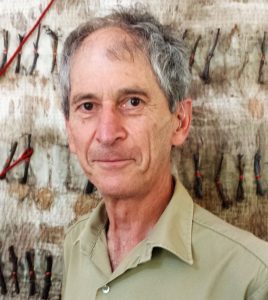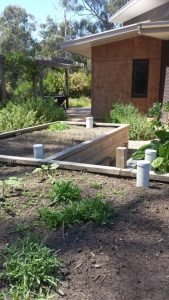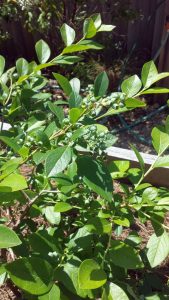Evan Gellert: volunteer and home producer
Judy Vizzari visits the garden of Evan Gellert, from Eltham. Evan is a member of the core team of gardeners who maintain the wicking beds at Eltham railway station and the vegetable planters outside healthAbility in Main Road, Eltham. He also volunteers at the Heritage Fruits Society in Templestowe.
 Today I visited a green place which is known, unsurprisingly, as Green Place, but which is actually called Dulaiwurrong Village.
Today I visited a green place which is known, unsurprisingly, as Green Place, but which is actually called Dulaiwurrong Village.
Dulaiwurrong is an aboriginal word and was the name chosen by the estate’s developer, in consultation with the Wurundjeri people, when the land was sub-divided in the early 2000s. It means platypus and refers to the platypus population which once thrived in the nearby Diamond Creek. This tiny, almost hidden, ‘eco-village’, which backs onto the Diamond Creek, is just a short distance from central Eltham. Once the area was occupied by a single dwelling and was known locally as Connie’s Farmhouse.
I was there to meet Evan Gellert, and his partner, Gillian Essex, who were amongst the first residents to build in the village.
It was a hot day. I parked outside the estate and walked downhill along a circular road dotted with family homes until I reached their house. The smells and sounds of stately gums and grasses and the promise of hidden wildlife along the Diamond Creek were charming – how pleasant, I mused, it would be to live here.
I later learn that the estate has strict sustainable housing codes which explains the residents’ allegiance to natural building materials like timber and mud, to the palette of earthy ochres, browns and eucalypt greens and to the indigenous gardens and plantings of vines, vegetables and fruiting trees which extended to the road’s verge.
The building codes of this village enshrine the use of sustainable design, of utilising solar panels, water tanks, air flow and building materials to produce low maintenance, environmentally conscious homes. It is evident that the residents are enthusiastic about their space as, Evan explained, they proudly maintain their handsome community meeting hub, common vegetable plantings and creek frontage during regular voluntary working bees. This is a thriving community – a hidden gem.
But this story is about Evan. He is, by profession, a Material Scientist/Polymer Chemist but, as is the case with so many of us, retirement has provided him with opportunities to explore his interests more fully and he has pursued them energetically at home and through voluntary work with a range of organisations. We discuss his garden first and then his other interests.

The home larder
I’ve heard that Evan is a successful grower of fruit and vegetables and, as I am an Eltham local who struggles with difficult soil, I’m keen to learn about his gardening techniques.
The view from the lounge out into the backyard and stretching down to the Diamond Creek invites exploration. Through the glass wall I see a solid timber, vine-draped pergola, softly swaying grasses and tall eucalypts. Patches of indigenous plantings dissolve into the softness of the bushland. A natural blend. The pergola frames the scene and invites me to look out towards the creek. I imagine the platypuses and eels that may live there and hope to glimpse the kookaburras, cockatoos, magpies and currawongs that inhabit the place. I’m keen to see and know more.
I ask Evan, “What is it like producing food on this block?” I resist adding a knowing ‘difficult?’
He cocks his head sideways and says wryly, “the vegetables need work.” He explains that, although the local soil isn’t a ‘natural’ for veggie patches, with the addition of manure, blood and bone, compost and lots of effort, good results can be achieved. I remember hours of back breaking effort in my patch.
Time to wander outside to check out those good results.
We’re moving past plantings of energetic raspberry canes promising bountiful berries, to a side patch of rather exotic blueberries and asparagus – I’m envious of Evan’s success with growing my favourite green vegetable, asparagus. He says that it’s taken several years to establish his plot but that it has been bountiful this year.
I see strawberry and rhubarb patches interspersed between decorative plantings – once again I’m envious – then around the corner an enormous U-shaped wicking bed is revealed. This must be the king of wicking beds as it takes up the space of about six ‘normal’ beds. It’s fed by rainwater from water tanks so is protected from drying out and, although spring plantings haven’t taken hold there yet, I imagine how verdant it will look when tomatoes and beans hang heavy, onions and lettuces flourish, and cucumbers tumble down its sides. This is a garden to feed a family. I wonder where the extra produce goes.
Avocados, a quince tree, citrus trees, a plum and heritage espaliered apples and pears line the verge and driveway. They’re laden with early fruit, not yet mature but promising future bounty and ample opportunities for home preserves. They also provide cooling shade for the house and enhance the streetscape.

I’m curious about the absence of pear slugs and vermin ravage. Apparently there are grubs living in the soil, but I learn that the local possums mostly leave the crops alone and that the trees are netted and grapes bagged well before ripening, to keep the corellas and rosellas at bay. Although they’re not totally effective, they do have “some success: and, I think that, with such a bountiful crop, sharing a little with the local birds seems fair.
Planter boxes in Eltham
Have you visited Main Road, Eltham lately, near healthAbility? If so, you may have noticed planter boxes sprouting herbs and vegetables. Or, are you a regular train traveller commuting from Eltham Station? Evan is a member of the core team of gardeners who furnish and maintain the wicking beds at the station and the vegetable planters outside healthAbility.
Plants for these beds are obtained from various sources including donations of home-grown seedlings and Evan says that, although graffiti of the wicking beds can be a problem, plant maintenance is minimal and the rewards are visible. I agree, having checked out both initiatives earlier. I am impressed – the plantings beautify our streetscapes, provide fresh free food to passers-by and encourage locals to ‘grown their own’.
Heritage Fruit Society
We move on to another of Evan’s exploits: heritage apple orchard maintenance.
He is a volunteer worker at the Heritage Fruits Society in Templestowe. The society manages a small heritage apple tree collection that is a part of the much larger commercial orchard known as Petty’s Orchard. Petty’s is managed by an orchardist family and their production includes many heritage apple trees, but only a small fraction of the 300 varieties managed by the society. Evan’s involvement includes year-round general maintenance but also lending a hand during labour-intensive periods, as in the January to June harvests and during winter, when tree grafting takes place.
It occurs to me that there are a lot of benefits to this work – no, not just the free apples – it’s about making a difference, keeping fit, building social connections, learning about gardening techniques and, importantly, preserving heritage fruits. It’s also about supporting local fruit production and Melbourne’s fruit-growing industry.
It seems that the Heritage Fruits Society is considering branching out into stone fruit in the near future so there’ll soon be even more for that group to learn and enjoy.
Eltham Lower Park
And then there’s Eltham Lower Park and yet another group of volunteers. If you walk around the pathway that leads from the miniature train to the platform over the river, you’ll see a cordoned off area lush with native plants. This is another team project – to eradicate introduced species and re-plant the area with indigenous plants, to reinstate the bush setting. I visited the parklands recently and saw the results of their work – they’re there to be enjoyed; little do we local residents realise how much voluntary effort and care goes into upgrading and maintaining our environment!
Citizenship tutoring
Oh, and on the subject of volunteering, Evan is also a Citizenship Tutor, assisting migrants and refugees to understand the intricacies of the Australian Naturalisation Test. He says he takes real pleasure in helping these newcomers to our country.
“So why do you volunteer?” I ask Evan. He regards me with a hint of a smile. Though I certainly don’t profess to reading his mind, I think I can approximate an answer – a love of gardening, a will to give, a joy in achieving, a need to be useful. Certainly he is a valuable member of our community.
o0o
We’ve spent over an hour talking and walking and exploring the village. I promise to pass on some lettuce seedlings to Evan and he swaps information about a natural pear slug inhibitor I can use. And then it’s time to go. I’ve enjoyed my visit with Evan and Gillian, learning about the productive but serene capsule which is Green Place/Dulaiwurrong Village. I leave via the circular road winding back up the hill and take in once again the gentle quiet of this hidden place. I carry with me a sweet impression of eco-village living.


I live in this village and love it! I think everyday how lucky I was to discover this hidden gem. Evan is a great neighbour and a very hard and much appreciated worker here. He quietly goes about his business in making a much admired edible garden. A true Eltham gem.
I love reading about Evan through beautiful words of one of my all time favourite authors, Judy. Thank you, Judy, for taking the time to write about this wonderful person. Evan, thank you for your generosity of time, knowledge, expertise and passion in the greening of the world in so many ways.
And thank you, Duang, for your interest and support! I really enjoyed the seeing, hearing, learning and writing experience!
A really interesting read. If Evan is a cheese maker, maybe he could share some of his knowledge with those of us who have had a go, but could learn more.
Thanks
Thanks for your comments, Sally. Evan was a lovely interviewee. I haven’t heard that he’s planning to run any courses in cheese-making soon (he’s so busy) but I suspect that, if he does, they’ll be mentioned in LFC newsletters.
This is a lovely, informative article about Evan’s and Gillian’s garden! I didn’t realize this eco-village existed as I’m guessing many people don’t. It’s nice to know that such places exist ‘in the suburbs’. I feel inspired to look further into this wicking bed ‘movement’. I enjoyed reading about the way you swapped seeds and information in the final paragraph. All in all, a good read!
Thank you Ruth. I think we’re lucky to be living in this beautiful area which supports such a strong interest in sustainability – loved writing about it and looking forward to learning more about its ‘green’ tendrils.